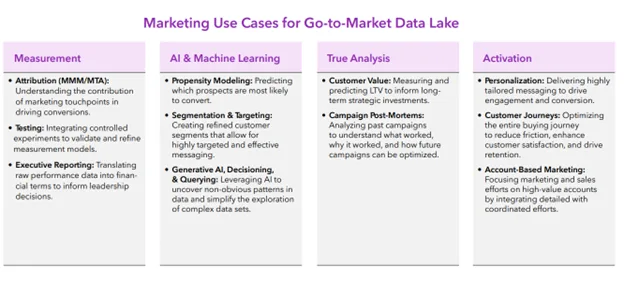Marketing leaders are demanding more flexibility around selection, implementation, and licensing for their Martech stack―and the industry’s answer is “Composability.” The term gained prominence in Martech circles in recent years and follows the microservices pattern popularized with cloud-based software architecture, where the components of a software system are broken down into smaller, discrete parts. Martech vendors are now orienting their platforms around this idea to provide more flexible deployment and licensing options.
This idea originated from customer frustrations with bloated Marketing software platforms as major vendors acquired dozens of point solutions over the past decade. Implementations became notoriously complex, and modules lacked strong integration or simply underperformed compared to best-of-breed alternatives. Composability shifted more control back to the client and focused on creating building blocks and better integrations. The approach has been welcomed across the industry, and many major vendors have modernized their offerings around this concept.
Evolution of Customer Data Platforms
The demand for composability becomes particularly evident when examining how customer data platforms have evolved and where they’ve fallen short. Marketing platforms have been embedding customer databases since the ’90s. The functionality started as storing basic customer lists and has grown to include a sophisticated set of attributes including preferences, behavioral signals, order history, and more. This was coined in 2013 as the “Customer Data Platform” (CDP) and the vision promised a 360-degree view of the customer that could be built inside marketing platforms without the help of IT. This vision resonated because customers were already using these platforms to orchestrate across an array of digital channels, and enriched data enabled additional use cases like personalization, cross-selling, and retention.
However, several limitations emerged with CDPs. First, they required pre-cleaned data, necessitating that transformations and cleansing be handled before import. Additionally, CDPs were not designed for advanced modeling and analytics, requiring data exports to dedicated data warehouse systems for complex analysis. Cost management also posed challenges, as most CDP pricing models were based on the number of stored records, which could inflate costs quickly. While CDPs are a great tool for digital activation and campaign execution, they fall short as comprehensive solutions for end-to-end go-to-market data management.
As organizations recognized these constraints, the prominence of CDPs has started to shift in the marketplace. The State of Martech 2025 survey revealed that CDPs fell from 27% to 17% and Cloud Data Warehouse ticked up from 21% to 24% as the center of the Martech Stack amongst B2C and B2B organizations. This trend indicates that a growing number of organizations are demanding more from their marketing data infrastructure.
Data as a First-Class Citizen
The solution lies in treating data as a foundational infrastructure layer rather than an embedded software feature. We call this solution the go-to-market data lake (GTMDL)—a strategy that places customer data in a modern cloud data warehouse such as Databricks or Snowflake. This provides greater flexibility, cost management, and analytical capabilities compared to using embedded databases within CDPs.
Importantly, the scoping and prioritization of a GTMDL should be guided by marketing use cases, not IT milestones.
This graphic illustrates key use cases the GTMDL supports.

The power of the GTMDL can be illustrated with a common direct-to-consumer (D2C) acquisition use case. The first step is to acquire a prospect list from a data provider and import it into the GTMDL. Next, data pipelines need to be created to augment, clean, and enrich the data with additional sources.
Once the data is prepared, a propensity model is created by training on historical customer sales data. This model identifies the optimal attributes to target when finding “look-alike” prospects in the new list. Each record on the prospect list is scored against the trained model, assigning a probability between 0-100%, indicating the likelihood that the prospect would convert as a customer.
The scored list is then segmented into testing groups (typically deciles) and exported to the activation platforms before being pushed out to the market. As the offers run in the market, performance data including clicks, impressions, engagement, and sales flows back into the GTMDL. This drives real-time campaign performance reports showing metrics like return on ad spend (ROAS) and enabling advanced measurement like multi-touch attribution models.
This entire workflow can be handled within the GTMDL, demonstrating why this approach is the preferred solution for marketing measurement and activation. Storage is cheap, and millions or even billions of rows can be imported without concern. Multiple languages such as Python, SQL, and R can be run in the platform to perform advanced data transformations and modeling. Compute resources can be provisioned on-demand, with costs incurred only during active processing. Finally, activation platforms integrate seamlessly to streamline audience deployment and engagement data collection―and you have full control of the data layer, which provides resilience from perpetual vendor upgrades and platform changes. Leading vendors like Databricks, Snowflake, and AWS Redshift all provide robust capabilities.
Conclusion
Marketers need the ability to both measure and activate their customer data, and the GTMDL makes this possible within a single platform. This solution enables measurement capabilities that CDPs have failed to deliver and that are essential for proving marketing ROI. The composable approach establishes GTMDL as the central hub, proving superior to an embedded CDP database.
The transition to this approach is more accessible than many organizations realize. Unlike the lengthy, resource-intensive CDP implementations that can drag on for months or years, GTMDL projects start with a use-case driven approach. Organizations can begin by focusing on their highest value measurement or activation challenge, such as multi-touch attribution or retention segmentation to demonstrate clear business value. This approach allows marketing leaders to build confidence while minimizing risk and resource commitments, ultimately enabling them to prove their ROI with real-time results and accurate measurement that drives budget allocation and business credibility.
For go-to-market leaders, the choice is becoming binary: evolve toward a data-centric, composable data architecture or risk being outmaneuvered by competitors who can measure, test, and optimize at greater speed and scale. In today’s marketplace, data-driven marketing is no longer a competitive advantage; it’s table stakes for survival.
Download our GTMDL whitepaper for a comprehensive guide to implementing this approach.

Download the whitepaper, “Building a composable go-to-market data stack”
Rethink your data foundation and lead the next era of AI-ready, insight-driven marketing.



